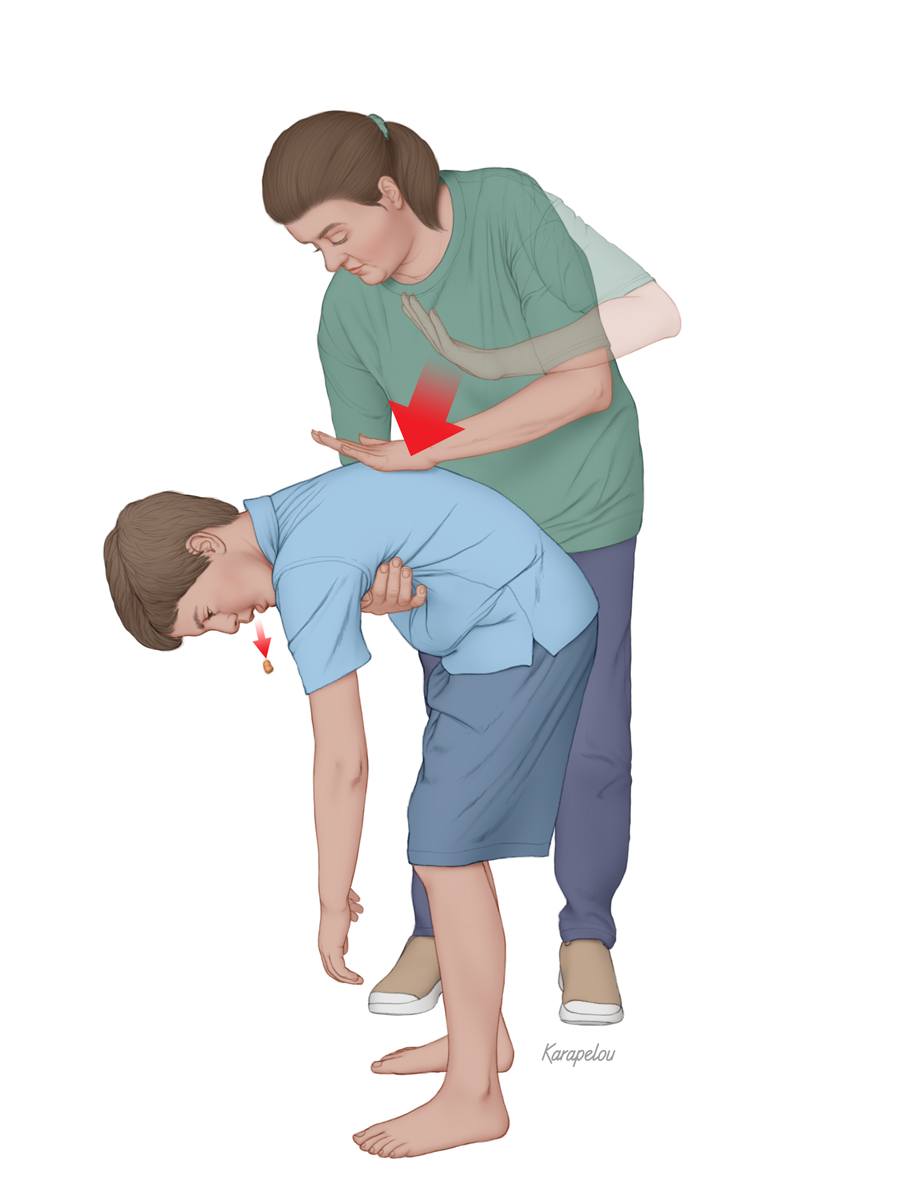Choking
Key Signs:
- Motioning towards throat or gesticulating without speaking
- Bluish tinge on lips, nail beds, or skin
- Coughing
- Wheezing
What to do if someone is choking but still able to speak, breathe, or cough?
- Encourage the person to keep coughing to try and clear the blockage.
- Be ready to help in case their airway becomes fully blocked or the choking becomes severe.
What to do if someone is choking but is NOT able to speak, breathe, or cough?
- Help immediately because they may lose consciousness.
- Give back blows by standing behind the person. Lean the person forward while supporting their chest.
- Give up to five sharp blows between the person’s shoulder blades with the heel of your hand (see below).
- Stop after each blow to check if the blockage has cleared.
- If not, give up to five abdominal thrusts (see below).

How to give abdominal thrusts (Heimlich maneuver)?
- Stand behind the person choking.
- Place your arms around their waist and bend them forward.
- Clench your fist and place it right above the person’s belly button then place your other hand on top.
- Thrust both hands backwards into their stomach with a hard, upward movement up to five times.
- If the object is still stuck in their throat, repeat the thrusts.
If the person’s airway is still blocked after back blows and abdominal thrusts, what do you do?
- Have someone else call 911 immediately. If you are alone, call 911 yourself and then continue helping the person.
- Continue with the cycles of back blows and abdominal thrusts until help arrives.
Asthma & Other Respiratory Diseases
Possible Signs/Symptoms:
- Severe wheezing when breathing both in and out
- Coughing that won’t stop
- Very rapid breathing
- Chest pain or pressure
- Tightened neck and chest muscles, called retractions
- Difficulty talking
- Feelings of anxiety or panic
- Pale, sweaty face
- Blue lips or fingernails
If someone has any of the above signs or symptoms and does not get relief from a prescribed medication, call 911! Do not leave them alone, and keep them sitting upright, warm, and calm. If they lose consciousness, check for responsiveness and breathing. If they are not breathing, start CPR if you are trained.
What to do if you or someone else is having an asthma attack?
- Sit upright (do not lie down)
- Take slow, deep breaths
- Remain calm
How to help with an inhaler?
If helping someone with an inhaler, they may be able to administer it themselves. However, note the following instructions so that you can assist if needed. You will most likely help by retrieving the inhaler and shaking it (step 1 below).
- Shake the inhaler vigorously for 5 seconds and pump the spray in the air until a fine mist is produced (2-4 times usually).
- The person with the asthma attack will bite the mouthpiece lightly and create a seal with their lips so air can’t escape.
- Tell the person you’re helping that you’ll count out loud for them.
- They (or you) will then pump the inhaler once. It is best if they inhale for at least 5 seconds, and hold their breath for 10 seconds. Again, count out loud for them.
- If their dosage is 2 puffs, shake the canister (no need to air pump) and repeat another round.
